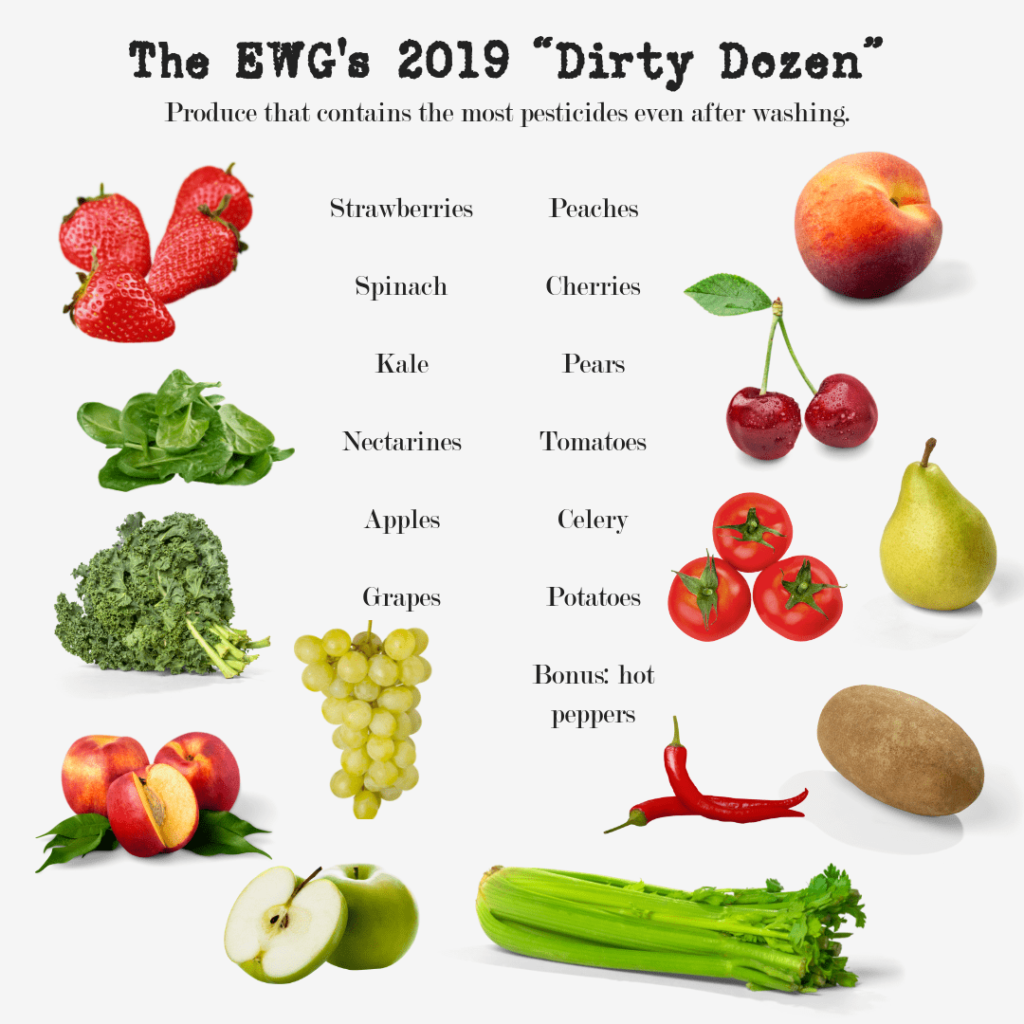
Dear Fellow “Want to Know” Health Seekers
It’s good to eat “dirty” for a clean bill of health. Just ask any doctor who studies the gut and microbiome—they will agree! Here is the caveat: The soil must be healthy and nutrient rich.. This incredible documentary explains the importance of soil to our health: https://grow.foodrevolution.org.
It is tough to find really good, organic, healthy soil in America. While some fruits and vegetables that are grown in non-organic soil can still be healthy, some non-organic produce contain harmful pesticides, fungicides, and antibiotics. In these cases, we must eat only organic, as ingesting these chemicals can wreak havoc on our precious bodies.
Garden of Eydie turns to the Environmental Working Group (EWG), a terrific nonprofit environmental organization. The EWG releases a yearly report that helps us to determine our best options for buying produce. The team tests thousands of samples, thoroughly cleaning and peeling all of the produce (just like most of us would do at home) to see if pesticides can easily be rinsed away. Then they create two categories: the Dirty Dozen (produce with the most pesticides) and the Clean Fifteen (produce with the fewest pesticides and the subject of my next blog).
The EWG’s annual Shopper’s Guide to Pesticides in Produce is an amazing tool. It outlines which of your favorite fruits and veggies are okay to eat (whether organic or not) and the ones to avoid. One exception: you know the farmer, are sure of the farming practices, and the produce is certified organic. Or, if the produce is just organic and you know that the farmer uses certified organic farming practices (It is a long and extremely expensive process for a farmer to get this certification and many cannot afford it, but their produce is of the same quality as farmers with the certification).
The lists vary from year to year, and this year’s Dirty Dozen includes some surprises!
Produce with the Most Pesticides — OMG!
Out of a whopping 41,000 samples, these twelve varieties of produce were found by the EWG to have the most contamination:
- Strawberries
- Spinach
- Kale
- Nectarines
- Apples
- Grapes
- Peaches
- Cherries
- Pears
- Tomatoes
- Celery
- Potatoes
And a bonus #13: Hot peppers
Key Facts About The Dirty Dozen
The full report includes lots of interesting nuggets that can help you to better navigate the produce aisle!
- More than 90% of samples of strawberries, apples, cherries, spinach, nectarines, and kale tested positive for residues of two or more pesticides.
- Multiple samples of kale showed 18 different pesticides!
- The most common pesticide found on kale (nearly 60% of samples) was Dacthal, or DCPA – classified by the Environmental Protection Agency since 1995 as a possible human carcinogen. It’s been banned in Europe since 2009.
- Kale and spinach samples had, on average, 1.1 to 1.8 times as much pesticide residue by weight than any other crop. Not all leafy greens are created equal!
- The USDA tests of 739 samples of hot peppers in 2010 and 2011 found residues of three highly toxic insecticides – acephate, chlorpyrifos and oxamyl – on a portion of sampled peppers at concentrations high enough to cause concern.
It’s mind-blowing when you think you’re eating healthy, but it you’re actually consuming all kinds of toxins.
What’s the Problem with Pesticides?
Are pesticides really such a big deal?
The short answer: YES.
Pesticides have frequently been linked to increased risk of health problems, including cancer. Eating organically grown foods has been linked to better health overall.
One study found that among nearly 69,000 participants, those with the highest frequency of organic food consumption had 25% fewer cancers than individuals who did not eat organic food.
Another study from last year found an association between the consumption of foods high in pesticide residues and fertility problems.
The science is clear! It’s better to avoid pesticides, as much as possible.
Eating all organic foods can be expensive, but using the Dirty Dozen and Clean Fifteen guides is a great way to pick and choose which fruits and veggies are worth splurging on, and when you can safely stick with conventional.
Of course, the best option is to grow as much of your own food as you can; you know exactly where it’s coming from and how it got started. There is nothing like stepping into my healthy garden and picking fresh foods to nourish my body and soul. However, I can’t grow everything! So, I supplement my own harvest with farmer’s market and grocery store finds.
Sometimes we don’t have access or don’t want to “invest” in organic produce, but we need our antioxidants and variety of nutrients, right? Garden of Eydie is here to help. According to Dr. Greger‘s book, “How Not to Die,” this is the most effective way to wash your Dirty Dozen and Clean Fifteen produce to get rid of the pesticide residue.
- A 10% salt-water rinse: add one part salt to nine parts water
- Dr. Greger’s tip: “just make sure to rinse off all the salt before eating”
Here is an added bonus for health while preparing your produce: Wash it gently, hold it lovingly, and imagine it filling your body with radiant health. I know this sounds a little crazy, but there is scientific evidence that the energy we give anything and everything can alter its make up. Garden of Eydie believes that we must plant the seeds for a great attitude, lots of gratitude, and healthy delicious food. Let’s put love into all the food we eat, and nourish ourselves from our head to our hearts, and all throughout our body.
Wishing you all incredible health,
Eydie
